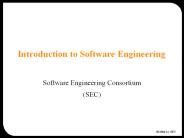My General Rules of Software Engineering - PowerPoint PPT Presentation
1 / 9
Title:
My General Rules of Software Engineering
Description:
9 yrs at Nortel Networks; software validation, software development management ... developing 3D graphics drivers to enable Intel's embedded 3D graphics hardware. ... – PowerPoint PPT presentation
Number of Views:35
Avg rating:3.0/5.0
Title: My General Rules of Software Engineering
1
My General Rules of Software Engineering
- David Steffy
2
Introduction
- David Steffy
- BS Computer Engineering, Virginia Tech
- MS Computer Engineering, NC State
- 9 yrs at Nortel Networks software validation,
software development management - 7 yrs at Intel software development management
- Currently, managing a team of engineers
developing 3D graphics drivers to enable Intels
embedded 3D graphics hardware. - Very strong believer in software engineering.
3
Have a process, and stick to it
- A process is not a burden, it is a tool that
helps you.If your process is a burden, its not
the right process. - You dont make money on your process, but your
process helps you make money. - Think of building software like building a house.
Start with requirements, create blueprints,
then break out the materials and tools.
4
Document document document
- Words are cheaper and easier to write than code.
- Writing things down forces questions to arise.
- You have something to share with others.
- You have something to jog your memory. (You
will forget something, I promise.)
5
Know your requirements
- Everything goes back to the requirements.
- Get them in writing. Get them prioritized.
- Respond to them in writing.
- This forms the basis of a contract (formal or
informal). - All subsequent steps refer back to the
requirements. - Non-customer-driven requirements
- Choice of languages and tools
- Testability and debuggability
- Regulatory
- Implied?
- Others?
- Requirements will change. They always do.
6
Design pays for itself
- Dont be in a hurry to start coding. Design
first. - Up-front design pays for itself, usually more.
- Drive refinements to the requirements early.
- Anticipate dependencies early and accommodate
them. - Words are cheaper and easier to rewrite than
code. - Design reviews are far more valuable than code
reviews. - Coding is more fun if youve designed up front.
Honest. - Your schedules will be more accurate.
- Remember testability, maintainability,
extensibility.Be prepared for the requirements
to change.
The happiest, most successful developers I have
managed did up-front design.
7
Scheduling
- Software developers are horribly optimistic
schedulers. - Schedules without design are worthless. Give
time for design before you demand or deliver
schedules. - Granularity in 1-week deliverables, preferably in
days. If you cant do this, then your design
isnt detailed enough. - Keep track of schedule dates
- Planned your first commitment, it doesnt
change. - Forecast your current commitment, it changes if
needed. - Actual what you actually achieved.
- History the best predictor. Learn from past
projects. - Padding isnt sneaky its practical.
Those who invested in design were far more likely
to meet their schedules.
8
Coding
- Source control is a must.
- The best coding standard is consistency. Beyond
that, avoid religious wars. - Code for maintainability. Keep it clear and
obvious. - Comments are good, but the best code is
self-documenting. - Code for testability.
- Build in ULT interfaces and debug mechanisms.
- Create test programs and utilities as you go.
- Code for extensibility
- Anticipate new features leave room to grow.
9
Validation/Quality
- Allocate sufficient time/resources to validation.
- Track defects (pre- and post-release). Use this
information to make decisions. - Validate against the requirements.
- Stability is critical
- Self control
- Source control
- For every two bug fixes, a new bug is created.
- Beware the one line change!Even one character
in C is powerful.































